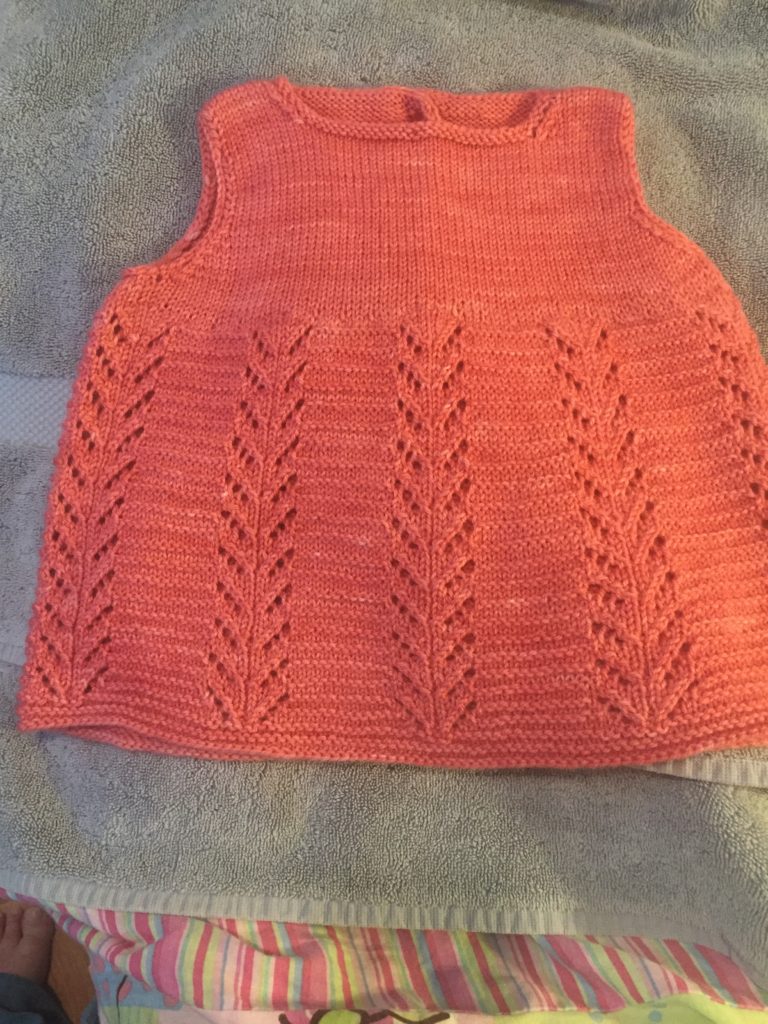
My dearest Zoe is expecting on September 7th. Luckily, having been raised by a knitter, she knows it takes some sort of time to finish a garment. First there was the picking of colors. I was very surprised that she chose springy pastels. Zoe wears blue jeans and gray or black or white almost exclusively. Plus the baby is due in Fall but the colors are not the least bit autumnal. We went with Lisa Souza Dyeworks.
I have known Lisa online almost as long as I have been a mother. In the early days if knitting community via yahoo groups or list servers we met in a couple of groups-most notably FiberTraditions. I chose to go with a dyer I ‘knew’ because I trusted the colors would be repeatable amongst various yarn bases and her bases are yummy! She generously spent time sending us various color combinations to go with the color Zoe and her partner both liked: Jonquil. I purchased 4 hanks of the super squishy and sproing-y Deluxe Sock! on March 15th.
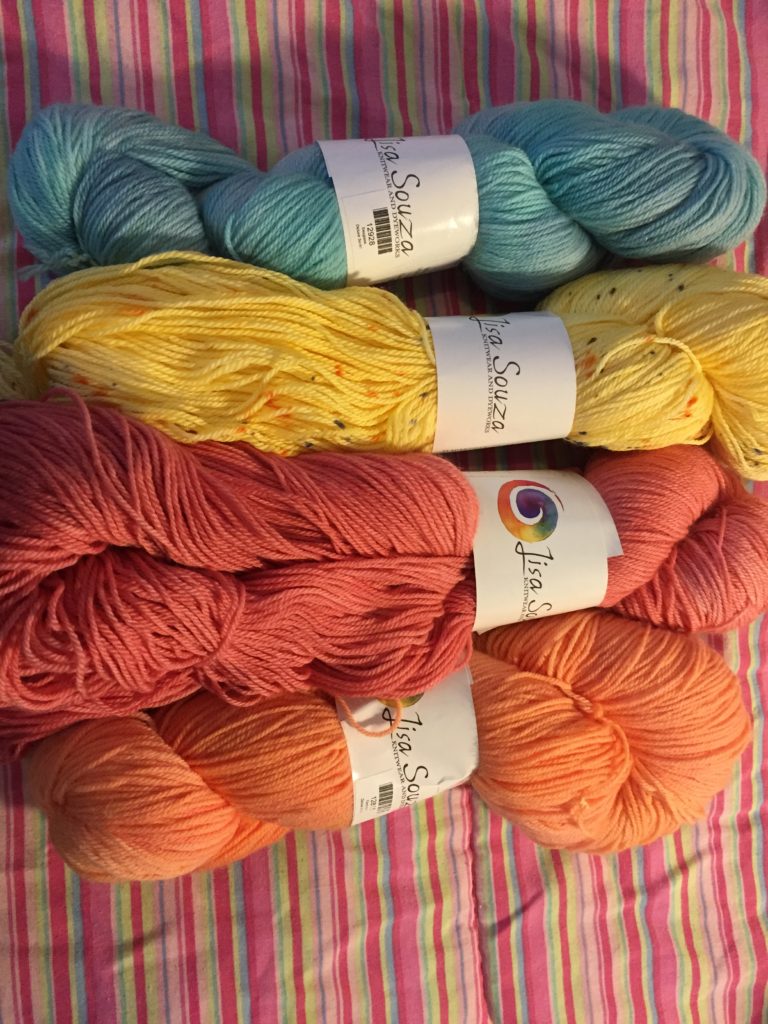
We also went over pattern selections. I suggested the usual Baby Surprise, Bog Jacket etc that I had knit for her when she was a baby but I ran into a problem. Zoe likes color block patterns-again a mystery since she herself wears solid colors- and I do not particularly care for them. She even picked out a color block poncho >.> I suppose if I were a better mother I would have cheerfully knit the item however I am not any better than I am and with my neck, arm, and hand problems knitting time has become somewhat sporadic and precious. AND I had gotten rid of most of my baby and children pattern booklets as well as unfavorited baby items on Ravelry years ago in an effort to streamline my life.
Another speed bump is that Zoe claims to not have much color sense and did not want to arrange these 4 colors, which she picked, together in one garment. I too do not particularly feel comfortable combining colors unless one of the two happens to be a neutral. All of this after having the dyer suggest the colors as going together in the first place! So I did what any sane person would do. I set the yarn aside to marinate in my stash. Not a deep dark cool corner marination either but right there on top of my desk where I couldn’t help but see it. And knit something else entirely.
Then one day, June 6th, while searching for cute baby patterns on Ravelry I stumbled upon Baby Nicole designed by Kate Oates. With this lovely pinkish color, Tuberose, staring me in the face and a nice lace and garter-ish combination for a springy ‘tee’ on my screen I hit buy, downloaded the pattern, wound my yarn, and started swatching immediately.
I did get gauge easily enough and did the first official cast on the next morning. The pattern calls for a crochet cast on and I am not very handy with the crochet hook. It took a YouTube refresher to remind myself of how to do the cast on and by now I should be a champ. This pattern calls for a whopping 144 st cast on-for the 6 month old size- which is then joined, increased to 189 stitches, and worked on lace pattern downwards to hem. This is why I say ‘tee’ because the empire shaping and wider lace body gives me the impression of a dress. I guess it is what one calls BabyDoll Top and I have yet to encounter a babydoll T-shirt. Anyway I somehow managed to be well into lace pattern before realizing I had twisted my stitches and had to restart. Twice. On the third try I transferred my cast on to 9 double point needles and laid them out into a nonagon and joined that way.
I find it difficult to rate a pattern when one makes changes to it. There is a part of me that calls knitting patterns recipes -no I am not that old!- so whenever I deviate I feel it is unfair to say any negative results are due to the designer. But I do have my own quirks and they went into play here.
The lace pattern set up row calls for purling so many stitches to set up the ‘deep garter’ and the instructions for deep garter call for purl round one, knit rounds two and three. In my head the set up round should be the final round of previous repeat so that on round one of the lace pattern and the garter fall on same round. Therefore, I didn’t do the purl round on the set up and happily did my purl rounds on round 1 and 4 of the 6 round pointelle lace pattern. This means that on the final round of body I had just worked 2 rounds of stocking stitch and the picture clearly shows a round of purl before the cast off. Sensibly so to help combat curling. If I had just looked at my knitting and seen the set up row was in purl and then done the next two in knit my purl rows would have fallen on row 3 and 6 of pointelle lace but I didn’t do that mental adjustment of written out rows of pattern until the very end when faced with those two rounds of knit. I think I maintained pattern by casting off as if to purl.
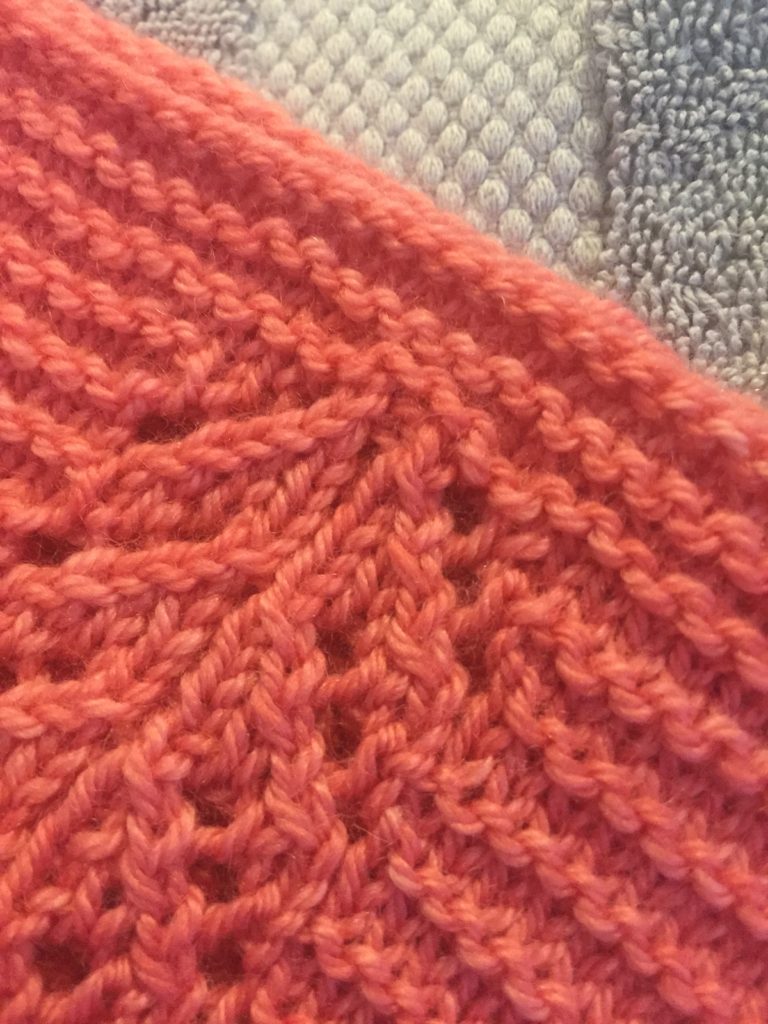
Then on bodice the pattern calls for the decreases at armhole and neckline to be slanted towards the opening. I automatically had my decreases going away from opening. I have done fully fashioned decreases as the designer specifies and it is good for maintaining the body of a patterned garment since the bulk of design stays uninterrupted and the decrease eats away towards the edge but this is stocking stitch and made no sense to me. Plus it is general habit to work a SSK to the left of an opening and a K2tog to the right of an opening. The openings for sleeves and neck both curl quite a bit and this is easily seen in the photographs for pattern put out by the designer. I do not believe my changing the decreases made any difference to the curling that comes from a minimal edging. I also started the front of bodice on WS as the back portions had been started & started my neckline 2 rows earlier than called for. This ended up being fortuitous because the pattern calls for a single crochet finishing of armhole and neck and I ended up riffing on my usual substitute; pick up stitches and bind off. On the neck I picked up on lower edge of buttonhole band all around neck and down button band, knit one row, then bound off creating a mini purl section. This lifted the neckline by two rows and offered a bit more oomph to fight stocking stitches tendency to curl.
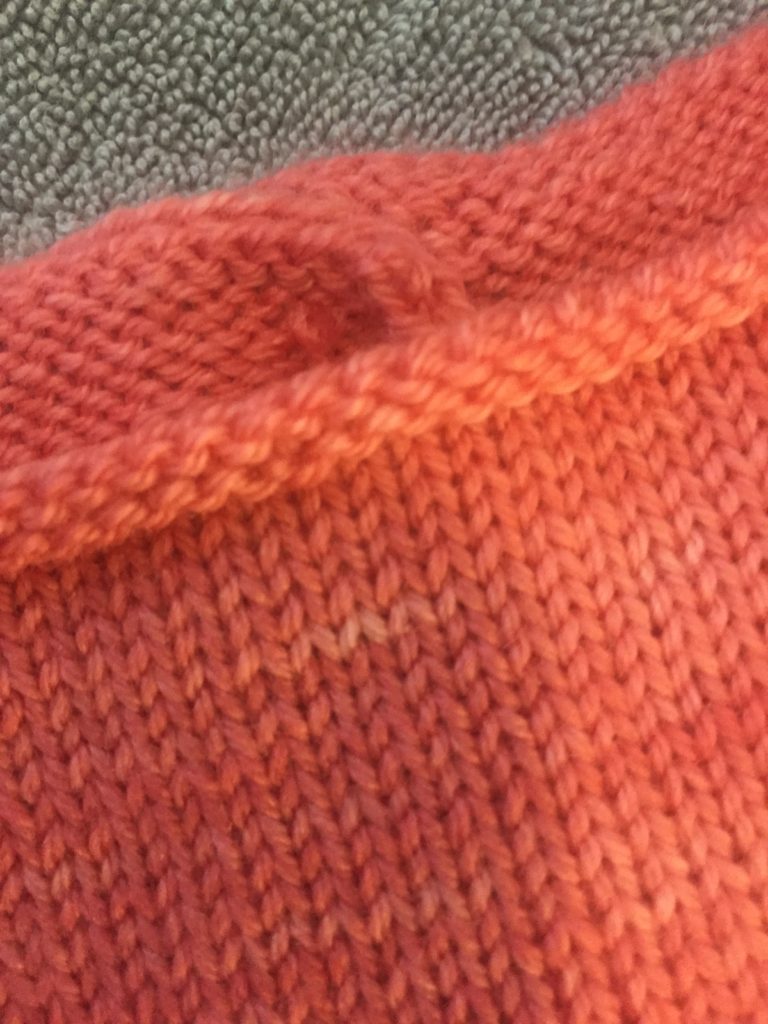
For the armholes I did my usual Pick Up and Bind Off instead of single crochet and for those who are unfamiliar with it this is what it looks like as an edge treatment:
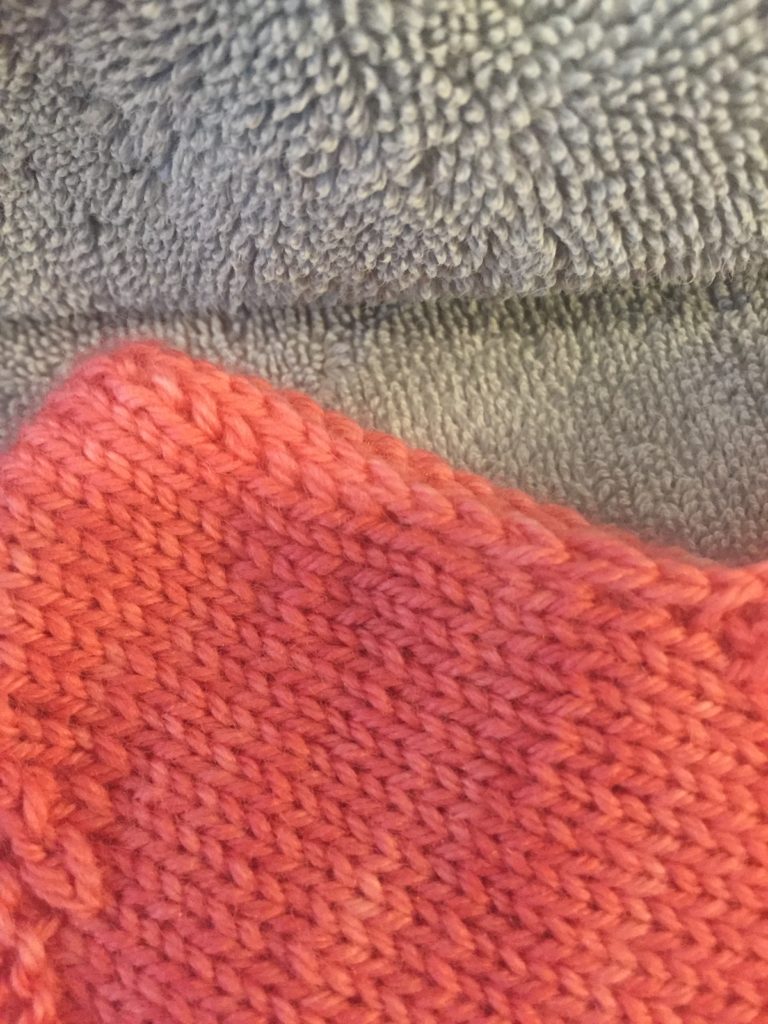
I will add that this method of treating an edge does tighten it up quite a bit especially if you are picking up one stitch per slipped stitch or half the number of rows. If I had planned I would have not bothered slipping the edge stitches and had more leeway which would have left the armhole openings more open.
I hated the buttonholes and kept losing stitches working it. Yes in addition to casting on three times I picked up my stitches to work the bodice twice to make sure my count wasn’t off due to that portion, redid the buttonhole, got to division row and was off again so went back again. This is, I am sure, entirely my fault and in no way whatsoever a reflection on pattern clarity. I ended up working Montse Stanley’s 3 row reinforced buttonhole from Knitting Handbook which involved minimal maths to calculate where to place them. I also lowered the top buttonhole. Nowhere in the pattern does it call for any finishing of buttonhole or button bands-not even tacking down the bottom edges which I did. The bonus of working the reinforced buttonholes instead of the 1 row suggested is I got to pick out bigger buttons. For some reason I think it makes the pattern a bit less fussy. Not that the pattern itself, designed for a cotton slub blend yarn, is in and of itself fussy but in a pink cashmere blend uhhh yeah twee even for a baby. The buttons give it a modern touch that was lost when I switched yarn base.
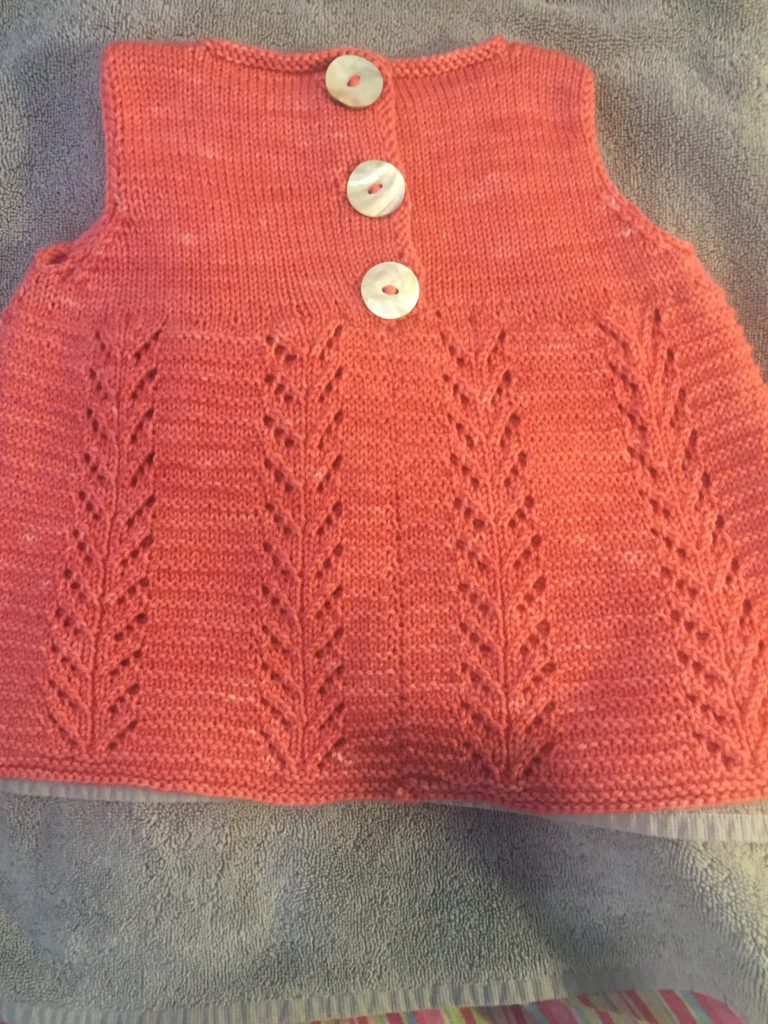
I read about jog-less garter in the round after having finished the body of top. If you choose to make this design, which really is not difficult and totally adorable despite my changes, you may want to read up on the various techniques. I have practiced none of these.
Yarny days and knitterly evenings~ Elka
